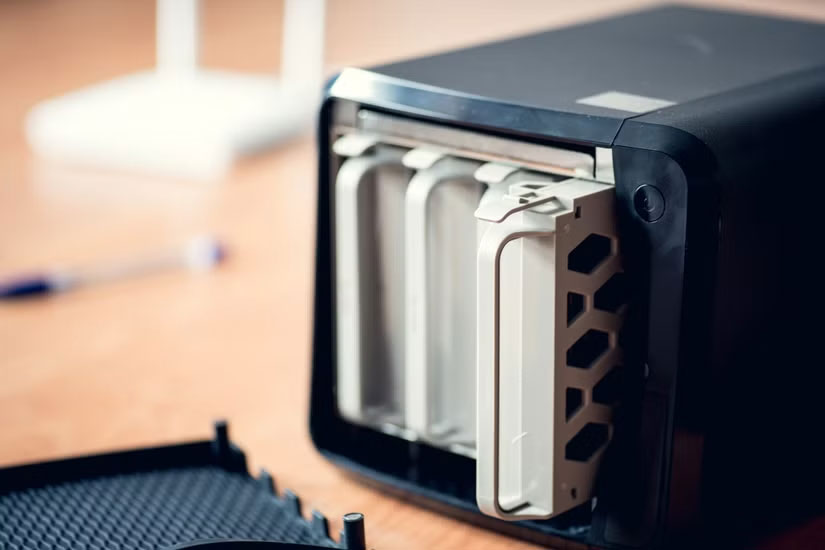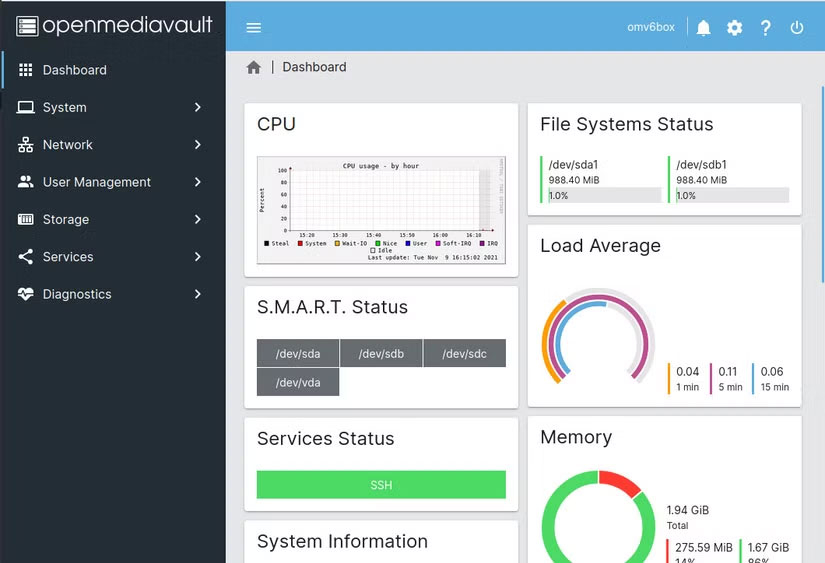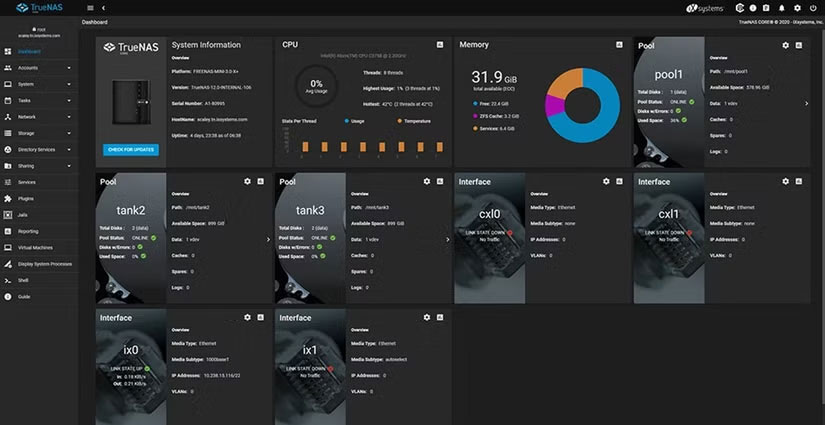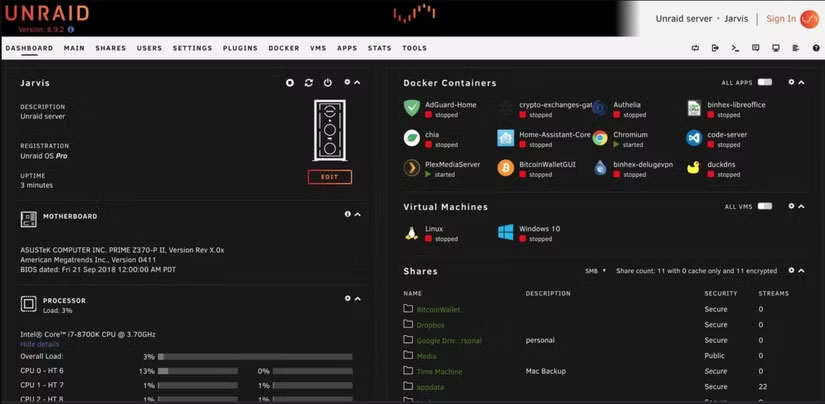OpenMediaVault, TrueNAS Core or Unraid is the best solution for DIY NAS?
Network attached storage (NAS) devices are great if you want to share data, content, or other data with your computer over a local network (or even the Internet ). Better yet, you can create your own NAS if you have a spare computer.
If building your own NAS seems too complicated, you can always buy a ready-made NAS box to save yourself the trouble of choosing a NAS OS and setting everything up. Just pop in the hard drives and you're done. However, if you want to build your own NAS, you'll have some tough choices to make.
While the hardware can be easy to decide on, with options like OpenMediaVault (OMV), TrueNAS CORE, and Unraid, there are quite a few choices when deciding on your DIY NAS operating system.
Comparing OpenMediaVault, TrueNAS Core and Unraid
In terms of basic capabilities, there isn't much difference between the three operating systems, but here's a quick comparison of how you can use each NAS OS. Beyond their basic role as NAS operating systems, all three offer features that may make your choice.
|
| OpenMediaVault | TrueNAS Core | Unraid |
|---|---|---|---|
| Basic operating system | Debian Linux | FreeBSD | Linux Slackware |
| Supported file systems | GPT, EXT3, EXT4, XFS, JFS and Btrfs | ZFS | XFS, ZFS, Btrfs and ReiserFS |
| Data Security | Provides software RAID support (no card or RAID controller required) | Provides software RAID support (no card or RAID controller required) | Use a parity-based system instead of RAID |
| Minimum hardware requirements | Any x86, x64 or ARM compatible processor, 1GB RAM, 4GB storage. | Intel 64-Bit or AMD x86 or x64 dual-core processor, 8GB RAM, 16GB SSD boot drive, at least two storage drives. | 64-bit processor running at 1GHz or faster, 4GB RAM, at least two storage drives |
| Price | Free of charge | Free of charge | $59 for Basic, $89 for Plus, and $129 for Pro. One-time purchase |
While both OMV and TrueNAS Core can host VMs, Unraid has a lot more going for it. Not only can you host Docker containers on Unraid without any additional configuration, but you can also run your own game server, set up WireGuard (a feature TrueNAS CORE also offers), automatically encrypt media, set up capture, encryption, and streaming servers, and more.
However, if you want to build something more than just a NAS or set up a home lab, Unraid is the OS to go for, provided you can afford the one-time cost. If you're still not convinced, there are a number of reasons why Unraid is the ultimate home NAS solution. OMV and TrueNAS Core are still great options for a basic NAS, offering additional functionality.
Now that that's the top line, let's take a closer look at the differences between each NAS operating system.
Hardware requirements and compatibility
- OMV requires any x86, x64, or ARM-compatible processor with 1 GB of RAM and at least 4 GB of storage.
- TrueNAS CORE does not support ARM compatible processors and requires at least a 64-Bit Intel or AMD x86 or x64 dual-core processor, 8GB RAM, a 16GB SSD boot device, and at least two identically sized storage drives.
- Unraid is a low-demand operating system, requiring only a 64-bit capable processor running at 1GHz or faster, at least 4GB of RAM, and two storage drives to ensure parity support.
Keep in mind that these are the minimum hardware requirements in the operating system documentation and your performance may vary. Additionally, these are minimum specs. You can install each of these NAS operating systems on much more powerful hardware.

Each NAS operating system can run on everything from old laptops to enterprise-grade servers. However, Unraid and TrueNAS CORE offer better compatibility with higher-end machines. This doesn't mean OMV won't run on a server; you just won't be able to extract as much data from it as you would running TrueNAS CORE or Unraid.
Please note that the author had trouble installing the free trial of Unraid on his machine, which easily meets the hardware requirements. Be sure to back up your data in case you switch operating systems on your NAS directly, as problems during installation can potentially brick your machine, especially if you are switching from a RAID-based OS to a parity-based OS, as Unraid is. That's just an example, mind you.
Storage management and system utilities
OMV

OMV is the most basic option of the three. It is based on Debian Linux and has a simple web-based administration panel where you can make changes to your network storage. However, OMV's simplicity also means that it is easier to update thanks to the Debian package manager. It supports multiple users, scheduled tasks, a certificate system, and even a plugin system for adding more functionality.
When it comes to OMV's storage management capabilities, you get support for GPT partitions and all major file systems, including EXT3, EXT4, XFS, JFS, and Btrfs. Btrfs also allows for snapshot management and automatically schedules error checking and deletion tasks.
TrueNAS Core

Next up is TrueNAS. It uses FreeBSD as its base and uses iXsystems' OpenZFS file system. You get a slightly nicer web interface with more control than OMV. As expected, you can schedule tasks and Cron jobs, run shell scripts, and add plugins for any additional functionality. You also get unlimited snapshots, group checkpoints, local and remote replication, and space-saving clones.
Updates are provided through the in-service update system. It's not the same as running a simple terminal command, but it's a convenient way to keep your OS up to date no matter what. You also get Single Sign-on (SSO) and data set management.
Unraid

Unraid offers all the features mentioned above, except with a much nicer and more accessible interface. It's based on Linux Slackware and supports XFS, ZFS, Btrfs, and ReiserFS file systems. Additionally, Unraid can manage a wide range of drives with the ability to add more later without reconfiguring. You also get support for running Docker containers and VMs right out of the box.
Data Security
OMV offers software RAID support for an extra layer of data protection. You can set custom quotas for each volume, create Access Control Lists (ACLs), and manage how the NAS is shared with other PCs. There are also plenty of monitoring tools, including Syslog and Watchdog, and you can receive email alerts if you want. Software RAID doesn't require any dedicated cards or RAID controllers, so it's also easier to deploy.
TrueNAS CORE also uses RAID. However, it also offers self-encrypting drives, file encryption, encrypted replication, WireGuard and OpenVPN support. Finally, you can create your own ACLs and IP address filtering to ensure unauthorized parties do not access the NAS. While you have support for both hardware and software RAID here, using hardware RAID is not recommended with ZFS-based file systems.
Unraid doesn't use traditional RAID-based technologies, meaning there's no need to rebalance existing data as you add more drives. Instead, Unraid uses a parity-based system, meaning you can mix and match drives of different speeds and capacities. The system bases every disk block on a 0 or 1 aligned across the currently used storage drives, with the result being either an odd or even number. This allows Unraid to account for any lost data regardless of the number of drives.
Price
- OMV and TrueNAS CORE are open source and completely free to use.
- Unraid costs $59 for the Basic plan, which supports up to 6 storage drives, $89 for the Plus plan, which supports up to 12 drives, and $129 for the Pro plan, which supports unlimited drives.
Luckily, this is a one-time purchase, so if you decide to go with Unraid, you'll only have to pay once, at least for the software. However, if you want to try Unraid first, you can try any plan for free for up to 30 days with no feature limitations.
Should I choose OMV, TrueNAS or Unraid?
Overall, if you want a quick and simple NAS setup without much hassle, and one that allows you to work with Debian, then OMV is the way to go. If you want to reuse an ARM device (like a Raspberry Pi) as a NAS, then OMV is your only option. However, keep in mind that due to its simplicity, its feature set is limited beyond its basic capabilities as a NAS OS.
TrueNAS CORE hits the sweet spot here, offering more features and a better interface at the cost of a little complexity. If you're willing to put in the time and effort, this could be a great option, especially considering it's free to use.
If you are using it, you should use Unraid. It is a great choice and is better than OMV and TrueNAS CORE in almost every way. However, it may be overkill for those who want to host a simple NAS, especially when you factor in the one-time fee on top of all the money you will spend on NAS hardware.
It's best to try all three operating systems to determine which one works best for you. Unraid seems like a lot of fun to use, but if you don't plan on using its extensive feature list, you'll probably be better off with something simpler and more lightweight, like TrueNAS CORE or OMV.
You should read it
- What is Windows Core? Is it the future of Windows operating system?
- QNAP provides an emergency warning about NAS device attack trends, showing how to secure NAS devices
- How to turn a Raspberry Pi into a NAS with OpenMediaVault
- Build NAS system
- 5 best family NAS devices for home data security, priced from 4.5 million
- What test you know about operating system P6
 6 iPhone Accessories That Are Wasting Your Money
6 iPhone Accessories That Are Wasting Your Money A Strong Password Isn't Invulnerable: It's Still Vulnerable to These 7 Attacks!
A Strong Password Isn't Invulnerable: It's Still Vulnerable to These 7 Attacks! Microsoft Quietly Rolled Out New 'Advanced Settings' Section for Windows 11 — Here's How to Enable It
Microsoft Quietly Rolled Out New 'Advanced Settings' Section for Windows 11 — Here's How to Enable It 6 Tasks You Should Automate Every Month to Avoid Burnout
6 Tasks You Should Automate Every Month to Avoid Burnout Don't let Microsoft 'kill' your Windows 10 PC!
Don't let Microsoft 'kill' your Windows 10 PC! Why should you give up your tablet? What should you replace it with?
Why should you give up your tablet? What should you replace it with?